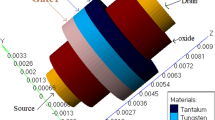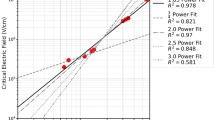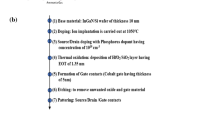Abstract
An analytical model for the surface potential and drain current of dual-material gate-all-around tunnel field-effect transistors based on evanescent mode analysis (EMA) is introduced. In the EMA, the channel potential is a sum of the solutions of the one-dimensional (1D) Poisson equation and two-dimensional (2D) Laplace equation. The EMA is preferred over the parabolic approximation due to the invariance of the characteristic length (λ) over the channel. The band-to-band tunneling rate is integrated over the tunneling volume to calculate the drain current. The accuracy of the model is evaluated by comparing it with results obtained from numerical simulations, revealing good agreement. The presented model could be easily integrated into commercial circuit simulators because of its accuracy and simplicity.







Similar content being viewed by others
References
Frank, D.J., Dennard, R.H., Nowak, E., Solomon, P.M., Taur, Y., Wong, H.S.P.: Device scaling limits of Si MOSFETs and their application dependencies. Proc. IEEE 89(3), 259–288 (2001). https://doi.org/10.1109/5.915374
Roy, K., Mukhopadhyay, S., Mahmoodi-Meimand, H.: Leakage current mechanisms and leakage reduction techniques in deep-submicrometer CMOS circuits. Proc. IEEE 91(2), 305–327 (2003). https://doi.org/10.1109/JPROC.2002.808156
Seabaugh, A.C., Zhang, Q.: Low-voltage tunnel transistors for beyond CMOS logic. Proc. IEEE 98(12), 2095–2110 (2010). https://doi.org/10.1109/JPROC.2010.2070470
Koswatta, S.O., Lundstrom, M.S., Nikonov, D.E.: Performance comparison between pin tunneling transistors and conventional MOSFETs. IEEE Trans. Electron Dev. 56(3), 456–465 (2009). https://doi.org/10.1109/TED.2008.2011934
Toh, E.-H., Wang, G.H., Samudra, G., Yeo, Y.-C.: Device physics and design of germanium tunneling field-effect transistor with source and drain engineering for low power and high performance applications. J. Appl. Phys. 103(10), 104504 (2008). https://doi.org/10.1063/1.2924413
Kumar, M.J., Janardhanan, S.: Doping-less tunnel field effect transistor: design and investigation. IEEE Trans. Electron Dev. 60(10), 3285–3290 (2013). https://doi.org/10.1109/TED.2013.2276888
Vishnoi, R., Kumar, M.J.: Compact analytical model of dual material gate tunneling field-effect transistor using interband tunneling and channel transport. IEEE Trans. Electron Dev. 61(6), 1936–1942 (2014). https://doi.org/10.1109/ted.2014.2315294
Gholizadeh, M., Hosseini, S.E.: A 2-D analytical model for double-gate tunnel FETs. IEEE Trans. Electron Dev. 61(5), 1494–1500 (2014). https://doi.org/10.1109/TED.2014.2313037
Toh, E.-H., Wang, G.H., Chan, L., Samudra, G., Yeo, Y.-C.: Device physics and guiding principles for the design of double-gate tunneling field effect transistor with silicon-germanium source heterojunction. Appl. Phys. Lett. 91(24), 243505 (2007). https://doi.org/10.1063/1.2823606
Ionescu, A.M., Boucart, K., Moselund, K.E., Pott, V., Tsamados, D.: Small slope micro/nano-electronic switches. In: 2007. CAS 2007. International Semiconductor Conference, vol. 2, pp. 397–402. IEEE. https://doi.org/10.1109/smicnd.2007.4519743
Gopalakrishnan, K., Griffin, P.B., Plummer, J.D.: I-MOS: a novel semiconductor device with a subthreshold slope lower than kT/q. In: Electron Devices Meeting, 2002. IEDM’02. International, pp. 289–292. IEEE. https://doi.org/10.1109/iedm.2002.1175835
Nathanson, H.C., Newell, W.E., Wickstrom, R.A., Davis, J.D.: The resonant gate transistor. IEEE Trans. Electron Dev. 14(3), 117–133 (1967). https://doi.org/10.1109/T-ED.1967.15912
Yeo, K.H., Suk, S.D., Li, M., Yeoh, Y., Cho, K.H., Hong, K-H., Yun, S., et al.: Gate-all-around (GAA) twin silicon nanowire MOSFET (TSNWFET) with 15 nm length gate and 4 nm radius nanowires. In: Electron Devices Meeting, 2006. IEDM’06. International, pp. 1–4. IEEE. https://doi.org/10.1109/iedm.2006.346838
Shao, Q., Zhao, C., Wu, C., Zhang, J., Zhang, L., Yu, Z.: Compact model and projection of silicon nanowire tunneling transistors (NW-tFETs). In: 2013 IEEE International Conference of Electron Devices and Solid-State Circuits (EDSSC), pp. 1–2. IEEE. https://doi.org/10.1109/edssc.2013.6628137
Verhulst, A.S., Sorée, B., Leonelli, D., Vandenberghe, W.G., Groeseneken, G.: Modeling the single-gate, double-gate, and gate-all-around tunnel field-effect transistor. J. Appl. Phys. 107(2), 024518 (2010). https://doi.org/10.1063/1.3277044
Saurabh, S., Kumar, M.J.: Novel attributes of a dual material gate nanoscale tunnel field-effect transistor. IEEE Trans. Electron Dev. 58(2), 404–410 (2011). https://doi.org/10.1109/ted.2010.2093142
Bardon, M.G., Neves, H.P., Puers, R., Van Hoof, C.: Pseudo-two-dimensional model for double-gate tunnel FETs considering the junctions depletion regions. IEEE Trans. Electron Dev. 57(4), 827–834 (2010). https://doi.org/10.1109/TED.2010.2040661
Vishnoi, R., Kumar, M.J.: A pseudo-2-D-analytical model of dual material gate all-around nanowire tunneling FET. IEEE Trans. Electron Dev. 61(7), 2264–2270 (2014). https://doi.org/10.1109/ted.2014.2321977
Kumar, S., Raj, B.: Compact channel potential analytical modeling of DG-TFET based on evanescent-mode approach. J. Comput. Electron. 14(3), 820–827 (2015). https://doi.org/10.1007/s10825-015-0718-9
Khaveh, H.R.T., Mohammadi, S.: Potential and drain current modeling of gate-all-around tunnel FETs considering the junctions depletion regions and the channel mobile charge carriers. IEEE Trans. Electron Dev. 63(12), 5021–5029 (2016). https://doi.org/10.1109/TED.2016.2619761
Gupta, S.K.: Threshold voltage model of junctionless cylindrical surrounding gate MOSFETs including fringing field effects. Superlattices Microstruct. 88, 188–197 (2015). https://doi.org/10.1016/j.spmi.2015.09.001
Aouaj, A., Bouziane, A., NouaÇry, A.: Analytical 2D modeling for potential distribution and threshold voltage of the short channel fully depleted cylindrical/surrounding gate MOSFET. Int. J. Electron. 92(8), 437–443 (2005)
Lee, J., Shin, H.: Evanescent-mode analysis of short-channel effects in MOSFETs. J. Kor. Phys. Soc. 44(1), 50–55 (2004)
Dash, S., Mishra, G.P.: A new analytical threshold voltage model of cylindrical gate tunnel FET (CG-TFET). Superlattices Microstruct. 86, 211–220 (2015)
Silvaco ATLAS.: Device simulation software, Silvaco Int., Santa Clara, CA (2013)
Vandenberghe, W.G., Sorée, B., Magnus, W., Groeseneken, G., Fischetti, M.V.: Impact of field-induced quantum confinement in tunneling field-effect devices. Appl. Phys. Lett. 98(14), 143503 (2011)
Marin, E.G., Ruiz, F.G., Schmidt, V., Godoy, A., Riel, H., Gámiz, F.: Analytic drain current model for III–V cylindrical nanowire transistors. J. Appl. Phys. 118(4), 044502 (2015)
Omura, Y., Horiguchi, S., Tabe, M., Kishi, K.: Quantum-mechanical effects on the threshold voltage of ultrathin-SOI nMOSFETs. IEEE Electron Dev. Lett. 14(12), 569–571 (1993)
Sajjad, R.N., Chern, W., Hoyt, J.L., Antoniadis, D.A.: Trap assisted tunneling and its effect on subthreshold swing of tunnel FETs. IEEE Trans. Electron Dev. 63(11), 4380–4387 (2016)
Author information
Authors and Affiliations
Corresponding author
Appendix
Appendix
The values of the coefficients A0, B0, C0, and D0 obtained from the boundary conditions [7] are given below:
Rights and permissions
About this article
Cite this article
Mishra, V., Verma, Y.K., Verma, P.K. et al. EMA-based modeling of the surface potential and drain current of dual-material gate-all-around TFETs. J Comput Electron 17, 1596–1602 (2018). https://doi.org/10.1007/s10825-018-1250-5
Published:
Issue Date:
DOI: https://doi.org/10.1007/s10825-018-1250-5




